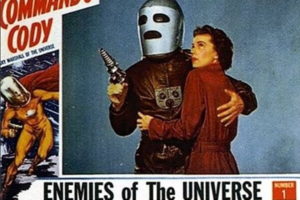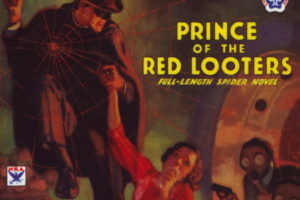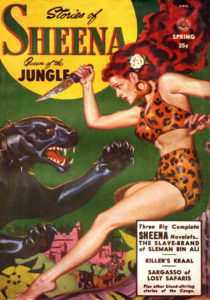
Sheena, Queen of the Jungle. The name is a familiar one. She appeared in a 1950s television first-run syndicated series, starring Irish McCalla. There was a 1984 movie starring Tanya Roberts, previously one of Charlie’s Angels. Six years later there was a syndicated TV series with Gina Lee Nolan that lasted two seasons. For more information about the various incarnations of Sheena, visit Paul Wickham‘s Sheena page.
Sheena was created for the comics, appearing from 1938 through 1953, first in Jumbo Comics and later in Sheena, Queen of the Jungle. Fiction House, which published the comics, was primarily a pulp magazine publisher. They had a jungle pulp series titled Jungle Stories, which featured the adventures of Ki-Gor, a white-skinned Tarzan-like character. Ki-Gor’s pulp adventures began in 1938 and ran through 1954. It was near the end of that 16-year run that Fiction House published a pulp magazine version of Sheena. The one-and-only issue of Sheena, Queen of the Jungle was published in the spring of 1951. Apparently it didn’t meet sales expectations, because there was no second issue published. The pulp business was a harsh and unforgiving one.
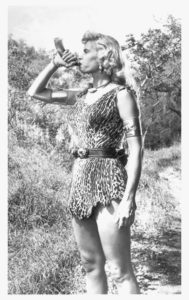
There was another Sheena story, after this pulp hit the newsstands. Three years later, Sheena made her final pulp magazine appearance in the final issue of Jungle Stories in 1954. I would guess that the publishers knew in advance that this would be the final issue of the magazine, and were trying to scrape up enough material to fill out a 96-page pulp. Maybe they had a left-over Sheena story that had been planned for the aborted second Sheena pulp magazine, and used it to fill out the final Jungle Stories issue. “Sword of Gimshai” was published with the writing credits going to Joséph W. Musgrave. The previous three Sheena stories, as published in the spring of 1951, were credited to James Anson Buck. Both names are presumably pseudonyms, house names for nameless Fiction House authors.
So, being the curious pulp guy that I am, I decided to read the sole Sheena pulp. The first thing I noticed when I opened it was the table of contents. The pulp contained three Sheena stories. That was most unusual for a character pulp. Usually there was one main story, a so-called “full-length novel,” featuring the main character, and then several shorter stories about unrelated characters to fill out the magazine. But no, in this one, there were three stories featuring the main character.
All three were touted to be novels, but their lengths of 18,000 words, 21,000 words and 19,000 words really stretched the definition of a novel. (For those of you who are curious, a novel is generally accepted to be 60,000 words or more.)
And interestingly enough, none of the three Sheena stories was credited to an author. Undoubtedly, they were written by one of the stable of Fiction House authors: Dan Cushman, James McKimmey, Stanley Mullin, W. Scott Peacock, or Robert Turner. At least the stories read the same as the Ki-Gor stories, so in my own mind I’m convinced. The pulp magazine also included a 4,000 word short story “Cobra Death” by Tom O’Neill. And those four jungle stories, along with the requisite advertisements, made up the entire pulp magazine.
‘The Slave Brand of Sleman bin Ali’
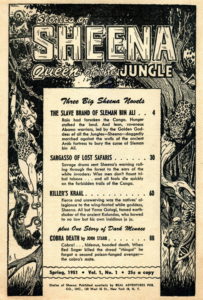
The first of the three Sheena stories was “The Slave Brand of Sleman bin Ali.” And as pulp readers have come to expect, you can’t take the title literally. There is no slave brand. There is a character named Sleman bin Ali, however. Apparently this Sleman bin Ali is a nasty character who has built up quite an organization, enslaving natives and stealing their ivory. It’s been going on long enough, and Sheena is determined to finally put an end to it.
We are introduced to Sheena as she steps out of a bathing pool, glistening in the African sun. Yeah, a little pandering, here. They knew what their audience wanted. But it was all strictly G-rated, even by 1951 standards. We quickly learn that Sheena leads a tribe of Abama warriors. She meets Rick Thorne, a trader and white-hunter. Sparks fly. All very proper and G-rated sparks, of course. She joins him as they “doggedly march against the walls of the ancient Arab fortress to bury the curse of Sleman bin Ali.”
Sheena has all the atributes you would want in a warrior princess. She is wise and leads her people who follow blindly, not understanding what she is up to, but having faith in whatever she does. She is beautiful, as Rick Thorne certainly notices throughout the story. And she’s fearless. In one place, she fights a leopard with nothing but a bow and a single arrow.
As the story ends, she has conquered the city built by Sleman bin Ali and has freed the slaves and sent him packing. Rick Thorne leaves, taking the stolen ivory back to the coast. But he vows to return. And indeed, he does, in the very next story!
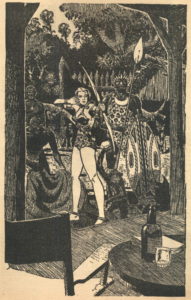
‘Sargasso of Lost Safaris’
The second story is “Sargasso of Lost Safaris” and, again, as you might expect, the title is not very descriptive of the story. The title makes me think of a “Bermuda Triangle” type of area hidden in darkest Africa where safaris go, but never return. Now that would make for a great story! But that’s not the plot we’re talking about, here. Pulps were famous for false advertising, and this is yet another case.
Poko Na is the bad guy, here. He’s son of the Bilina’s chief, and he forms an uneasy alliance with Ferdinand Lavic, a rotter of the worst sort. Poko Na is going to show Lavic the secret entrance to a hidden valley filled with ivory. The two will get rich and head off to merry olde England to spend all their money. Rick Thorne runs into Lavic. Sheena runs into Poko Na. And then the two protagonists combine forces to fight the evil duo. In the end, there’s plenty of blood and spears sticking out of backs, and the good guys win out, yet again.
This story has a bit of a “Elephants’ Graveyard” vibe to it, mixed in with a little bit of “The Lost World.” You see there’s this hidden valley that can only be accessed through an underground tunnel and a sheer cliff. In this valley, elephants live, grow old and die… and leave behind their bones and masses of ivory. Also in this valley live some dinosaurs! The incognito author doesn’t actually use the word “dinosaur” but there’s no doubt that these huge lizards, gigantic reptiles are “…unquestionably a saurian monster that should have been extinct for several million years!” There’s not a lot of dinosaur action, but there is one pretty good battle scene between the prehistoric beast and Rick Thorne and Sheena.
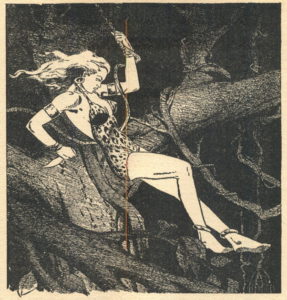
Sheena has pretty much most of the attributes of Ki-Gor, from Fiction House’s other jungle pulp. She swings through the trees on vines, much as Ki-Gor and Tarzan both do. Now that wasn’t mentioned in the first story, but is quite common in this second one. She has a chimpanzee companion (we won’t say pet) by the name of Chim. Unlike Tarzan, she does not speak the language of the animals. She may speak to Chim, but he just stares back at her, uncomprehending. Well, at least he doesn’t understand until the plot of the story demands it. Then, suddenly, he seems to understand. Strange how that works, eh? Another reason we love the old pulps!
It would seem that much has happened between the first story and this second one. We are told that “Most of Rick’s fabulous jungle craft, as a matter of fact, had been developed on long treks with Sheena.” Apparently in the time between the two stories, the two have been on long treks together. Hmmm… Interesting. There’s not much sign of romance between the two. No kissing, like in the first story. “Just a faint smile on her lips. That was all that was necessary to show her deep affection in this instant.” Okay, let’s see where the third story takes us.
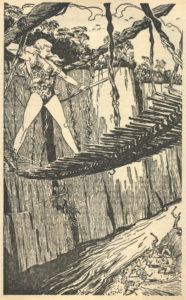
‘Killer’s Kraal’
The third Sheena tale is titled “Killer’s Kraal.” A suitably vague title, if you ask me. It could mean anything… or nothing. A “kraal” for those of you not up on your jungle lingo, means a small village of huts surrounded by a stockade.
In this story, Sheena has romantic feelings for Rick Thorne. A definite change since story #2. She fights against those primitive urges, because she knows she is not for him. She is filled with “poignant yearnings.” Okay, this story was definitely not written by the same guy who wrote the second story. In that one, there was no such attraction between the two.
We are told that it was eight months ago that Rick Thorne came up the Kwango River and had first met Sheena, golden-haired goddess, she of the leopard-skin costume. Considering he had to make safari back to the coast with all that ivory, eight month sounds about right to make this the second story in the series. I think they got “Sargasso of Lost Safaris” out of order. That one should have come after this, not before it.
As for our story, Sheena encounters Rick Thorne as he is being attacked by strange warriors. He is wounded, and she nurses him back to health. And during his recuperation, there’s a little smooching going on in the moonlight. Across the African night air they hear the strange sounds of a ghost drum… the deep resonance of the drum of Yamo Galagi, the infamous warrior and chief who created an African empire some 70 years ago. The drums call the young warriors of the Abama to the ancient city of Massumba, where they will worship the newly reborn Yamo Galagi. Okay, enough of this kissy-face business, and time to get to work. It’s up to Sheena, Rick Thorne and Ekoti, young chief of the Abama tribe, to find the source of that ghost drum and defeat the evil power that seeks to enslave all of Africa.
To fill out the pulp’s hundred pages, there is a short story titled “Cobra Death.” It’s not a bad little tale about a thoroughly despicable white hunter who quickly reforms when he faces cobra death. It’s also quickly forgettable. No, it’s Sheena that drew you to this pulp.
Pretty standard jungle fare
All three Sheena stories are pretty standard jungle fare, if you ask me, very similar to the 16 years of the Ki-Gor stories from the same publisher. Unlike the stories of that other jungle character, Tarzan, these stories as published by Fiction House lack any element of the fantastic. They are a bit bland, so I can’t give this one a hearty recommendation. If you want some jungle action, and aren’t too discriminating, this might fit the bill. Otherwise, you might do better to skip it.

